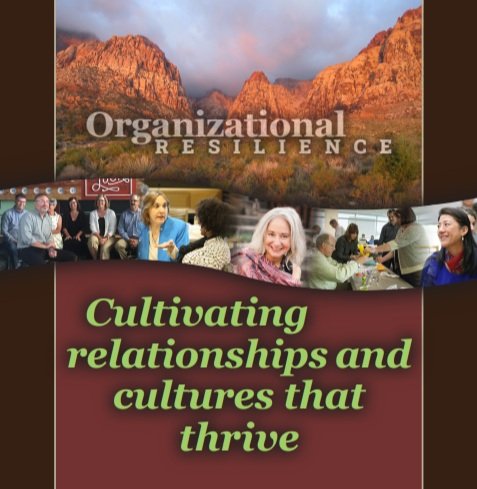Develop Leadership Resiliency - for you, your team, and your organization's well-being
/This week I facilitated a client’s offsite retreat. Six months ago, they restructured their business - increasing the size of the leadership team and reexamining roles and responsibilities. All very common organizational shifts during cycles of growth and change.
I conducted an exercise I called, “Taking the Pulse”, to see what was working, what was not (yet) working, and what they were learning from the first half of the year. They spoke of the collective energy and passion, the evolving ability to see the firm’s vision, the openness to having hard conversations, and that as a leadership team they hadn’t quite found their rhythm. One participant captured it well in saying, “Building trust and respect amongst your peers takes time.”
Trust and respect are foundational to high-performing teams. When we invest in building mutual trust and respect in our relationships - our work and our organizational health - is more robust. The presence of trust and respect in a work relationship makes for what my client calls, “worthy collaborators.” And the experience is transformational (and fun!). Yet we often gloss over how to effectively build these relationship skills to competently and confidently lead! Leadership is not about having all the answers, or even fixing all the problems, rather, it is about creating a culture of shared resiliency.
Defining Resiliency
My working definition of resiliency is the capacity to prepare for, adapt to, and recover from adversity, change, challenge, and stress. Leading is hard. Resilient leadership is a belief system and learned skill set designed to help leaders navigate the constant uncertainty they face, together.
As I was formulating the program for the retreat, I realized I wanted the team to feel safe to speak up, contribute, and engage in respectful candor. I wanted each leader to be seen and heard for who they are and what they bring. I wanted them to be open – actively listening to each other with curiosity, not judgment or resistance. I wanted them to leave the retreat owning their roles.
I also wanted to hold space for the team to connect with each other and learn together. This of course requires a degree of vulnerability, and I was not sure what their appetite was for that at this stage of their journey. Then it struck me, what I really wanted was to empower the members of the leadership team with a key resiliency trait – a growth mindset!
“People with a growth mindset see challenges as opportunities for growth and discovery; whereas those with a fixed mindset see them as impossible obstacles and tend to confine themselves to the boundaries of their comfort zones”, Ashley Pena, LCSW, Executive Director, Mission Connection
Psychologist Carol Dweck developed the concept of the growth mindset after decades of research, and popularized it in her 2006 non-academic book, “Mindset: The New Psychology of Success”. Since then, Dweck’s protégé, social psychologist Marcy C. Murphy, has shown that mindset transcends individuals. Her research reveals that, “organizations and teams more geared towards growth inspire deeper learning, spark collaboration, spur innovation, and build trust necessary for risking-taking and inclusion.”
I am currently reading Murphy’s book, “Cultures of Growth: How the New Science of Mindset Can Transform Individuals, Teams, and Organizations” as part of a client book club. It was originally recommended by organizational psychologist, Adam Grant, who suggests the book as a “…useful road map to building a learning organization and unlocking the potential in people.”
What does it mean to have a growth mindset?
A growth mindset reflects the belief that abilities and intelligence can be developed through dedication, hard work, and learning.
Key characteristics include:
1. Embracing Challenges: Seeing challenges as opportunities to grow rather than obstacles that thwart progress.
2. Persistence. In the face of setbacks, perseverance prevails.
3. Effort. Valuing the work as a path to mastery.
4. Experiencing mistakes as discoveries, portals for learning.
5. Welcoming feedback as a mechanism for continuous improvement.
6. Finding inspiration, not envy, from others’ successes.
7. Adaptability. Being open to new ideas and willing to adjust approaches.
8. Curiosity. A desire to grow that is so strong, one values the learning over being right. (Or as one of my clients is fond of saying, “I like being right so much that when I am wrong, I just change my mind!”)
An essential complement to the growth mindset, is the capacity for self-compassion. By alleviating harsh self-criticism, self-compassion reduces the fear of failure, making it more inviting to embrace the risks necessary for growth. Self-compassion fuels motivation and enthusiasm, rather than feeding self-doubt and negativity.
Embracing challenges, fully applying our best effort, and expanding our potential does more than deliver results. I would contend that living from a place of curiosity and a desire for discovery brings a sense of wonder and expansiveness to one’s work. It offers us deep satisfaction and self-efficacy. Practically, it also helps us have a broader perspective of what is and what is not significant in the grand scheme of things (which can help mitigate stress). A bonus: approaching life this way tends to reduce our feelings of regret!
Experiencing our work with a growth mindset is a way for leaders, teams, and organizations to more sustainably achieve holistic success. It sets the tone for learning, growing, and achieving together. Resilient leadership is an invitation to lead an authentic, thriving culture, while fortifying one’s own energy for the long game.
As you travel on this path, remember the words of Winston Churchill, “Success is not final, failure is not fatal: it is the courage to continue that counts.”
///



